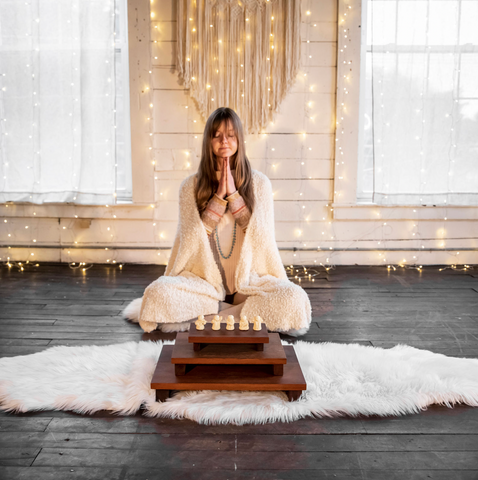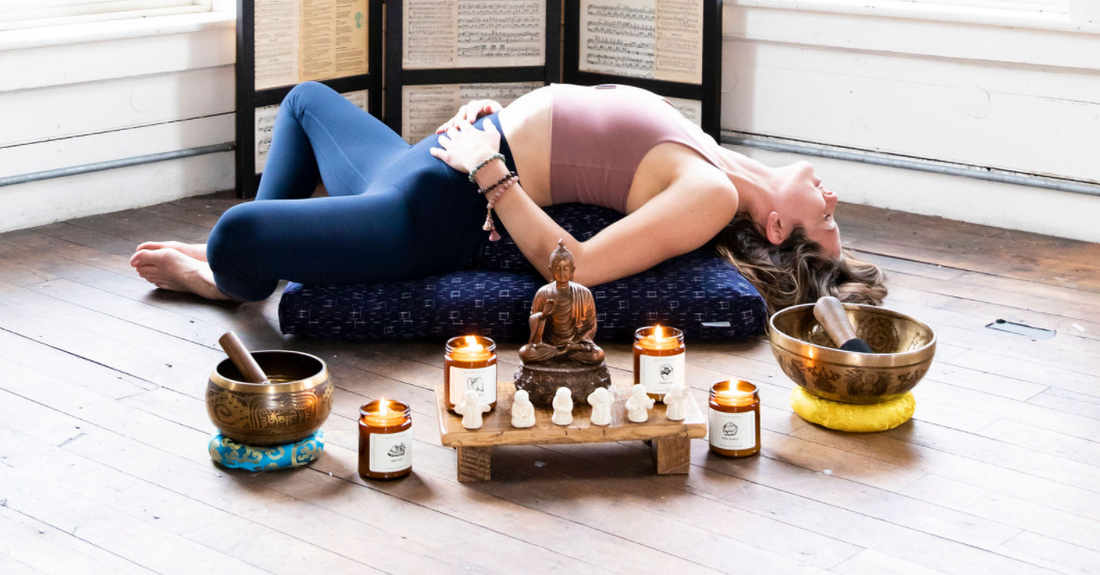A sacred space is a place dedicated to connecting with yourself and your inner spirit. It is a place of deep personal significance and, therefore, should be highly personalized so that its meaning is most sincere to YOU. It can be whatever feels most fitting and grounding for you - whether that be a full meditation room, a spot in the garden, or a simple home altar in a bedroom corner, creating a sacred space is an intimate and subjective experience.
Let your heart guide you to create an environment that will best facilitate your connection between mind, body, and spirit. No matter if you’re a lifelong meditator who is just looking to modify your daily ritual, or a beginner who is new to all things Zen and Dharma, a meaningful sacred space is something anyone can create in their own home.
DharmaCrafts has everything you need to make a spiritual altar and sacred space that speaks to both tradition and your own inner spiritual self. Follow these simple guidelines to find what the perfect sacred space should be to you.

Choose a Space That Can be Entirely Dedicated to Your Practices
Us humans are beings of habit and association. This is why (for those of us that don’t have difficulty sleeping) we grow sleepy the moment we lay on our beds. In this same way, we must build up our association with our sacred space. By giving your sacred area a proper, permanent setting, your mind will subconsciously come to associate the entrance into this space with its designated time to unwind and enter a state of calmness.
Whether you dedicate only a simple zabuton on the floor, or a whole sacred room entirely centered around self-reflection, try to allow that space to only be disturbed or occupied while practicing your craft.
Picking the Perfect Spot
The ideal sacred space should be warm and inviting with minimal distraction. Sunrooms, attics, spare rooms, porches, patios, and gazebos can all make for wonderful sacred spaces. No matter where you choose, the space should generally be:
-
Quiet and secluded as possible: Away from the hustle and bustle of the home or neighborhood.
-
Bright: Warm, natural light will help keep you energized yet relaxed as it warms your skin. A secluded spot outdoors on nice days, or a room with a window that can be opened to allow fresh air and a breeze to enter is even better!
-
Comfortable: Choose somewhere with soft flooring (such as carpet, rugs, or grass), and bring pillows or a chair to make it just right. Cover yourself with a meditation shawl or blanket to keep yourself comfortable during the cooler months or in drafty rooms. Use a zafu and zabuton cushion set or meditation bench to create a sitting surface that is ideal for your flexibility level. Add in any of our additional support cushions to perfectly customize your meditation seat to your liking.
-
Inviting: Create a simple, clean space designed around the intention of meditation and peace. Think: muted colors, few distractions (like clutter and unrelated decor), special personal mementos and style choices, etc.
Decide on an Altar Piece That’s Right for You
Altar tables are commonly used as the centerpiece of a sacred space; this can be as grand or simple as you want. Perhaps a simple yet stately tall table is all you need for an altar, or maybe you find something small and ornate to be more to your taste.
An altar table can be whatever piece of furniture suits your taste, your space, and your needs best. Regardless of the style, it should serve as a way for you to center your focus and intentions within the meditative space. It and the things you adorn it with give deeper purpose to your space and your practices.

Offerings and Other Objects
Think of your home altar as a pedestal where you elevate the things that are most meaningful to you - in all aspects of life. These will be the focus and motivation while you rest and recharge your spirit. Many meditation practitioners find the “5 senses rule” to be a good guideline for choosing a harmonious balance of elements to include in their sacred altar space and to create a full body experience.
-
Scent: Incense has been used while meditating by Buddhist monks for centuries because of its abilities to open the spiritual side of the soul while simultaneously calming the mind and heightening concentration. Essential oils or candles may be used as substitutes as well. Including aromatherapeutic items in your daily meditation practice helps to soothe anxiety and enhance focus.
-
Sight: This sense is the most flexible to accommodate since the possibilities are nearly endless. Choose whatever objects you find the visual of helps you enter your Zen state and bring you comfort. Some ideas include: statues/ figures, crystals, photos of loved ones or teachers, personal mementos (like a gift from a loved one, a seashell, or handwritten note), plants, and so much more. The choices are truly endless.
-
Touch: The action of lighting a candle/ incense or applying essential oils to the skin can be a physical aspect of your daily ritual that helps your mind enter a tranquil state. Praying with mala beads or holding crystals can also bring added positive energy into the experience while offering physical stimulation. Placing offerings in traditional offering bowls or using a singing bowl are also meaningful ways to create a physical ritual.
-
Taste: Sipping warm, flavorful tea before or during your session, or consuming anything that leaves a pleasant taste in the mouth, allows every sense to be engaged and in splendor while you meditate.
-
Sound: Sound has a powerful effect on the mind and is supremely effective at transporting you to the meditative state. While you meditate, play relaxing music softly, listen to the sounds of nature, use a singing bowl, or listen to a meditation script to fully envelope your senses.
Make a Habit of It
It’s hard to stick to a new routine - especially one that requires deliberately stepping away from the hecticness and demands of daily life. Even in your few moments of stillness during the day, it can be difficult to detach yourself from thoughts of what else you need to do and where you have to be next.
By engaging in these times of escape and forcing your mind and body to quiet down for a brief time every day - even if only for a few minutes - it will gradually become more natural. As mentioned above, we are creatures of habit. You may even find yourself eventually craving this daily break!
Participating in or utilizing meditative aids like meditation scripts, breathing exercises, and using a meditation timer can also be extraordinarily helpful in getting you into the routine of what you are practicing, be it yoga, meditation, mindfulness, etc.
Your meditation routine and sacred space are meant to bring serenity to you and only you. A sacred space is not supposed to be created using a set of rules and utilized in any specific way, but rather in the way that brings you the greatest sense of peace and focus. This blog is only intended to be used as a guideline and source of inspiration, not as a rule book on your journey of creating your perfect sacred space at home.
If you'd like to learn how to create an outdoor meditation space, please see our blog here.


